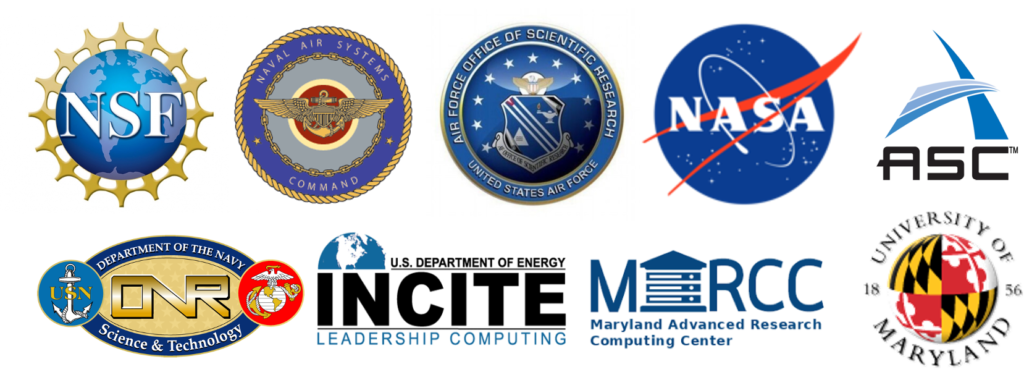All of our research projects fall in the category of computational science, which is the multi-disciplinary mix of applied math and numerical methods, programming for massively parallel supercomputing, and (for us) the physics of turbulence and fluid mechanics. No person is truly an expert in all of these fields, but a successful computational scientist will be an expert in one of them, a capable practioner of a second one, and at least an aware user of the third.
Our overall vision is to bring high-fidelity turbulence simulations to the point where they can be routinely applied to real problems in engineering practice. This vision informs all of our work. In some projects we use supercomputing resources to learn more about turbulence physics, and we then try to take that knowledge to build new theoretical models that can be used to make predictions, build lower-cost models, and in general encode our understanding. In other projects we directly develop new algorithms or mathematical models, and then always with a mindfulness of how they would be used in practice (e.g., no spanwise averaging like some subgrid- or wall-models for LES; an awareness of the required computational cost; etc).
Current interests
- Wall-modeled large eddy simulation.
- Solution-adaptive ways to find the optimal thickness of the wall-modeled layer.
- Wall-models that remain accurate in the presence of strong acceleration/deceleration, three-dimensional skewing, and laminar-to-turbulence transition.
- Grid-adaptation for turbulence-resolving simulations (LES, DNS, DES).
- Residual estimators that accurately reflect where errors are introduced in broadband LES.
- Integration of residual estimators into grid-modification or grid-generation tools.
- Uncertainty estimation for turbulence-resolving simulations.
- Aiming for methods with similar cost as the underlying simulation method — better an approximate method at reasonable cost than an exact method at an extreme cost (paraphrasing John Tukey, co-inventor of the FFT algorithm).
- Blending physics-based thinking with mathematical tools and an engineering sense of the cost/benefit balance.
- Turbulent flows.
- Near-wall scaling theory for wall-bounded turbulence at all Mach numbers and wall thermal boundary conditions.
- Shock/boundary-layer interactions, including the effects of non-adiabatic walls, three-dimensional effects, and how one can model the near-wall turbulence.
- Non-canonical effects on turbulent boundary and shear layers.
Support

Our research is or has been supported by the National Science Foundation, the Naval Air Warfare Center Aircraft Division, the Air Force Office of Scientific Research, the NASA Transformational Tools and Technologies project, the Office of Naval Research, the Naval Research Laboratory, and the NNSA Predictive Science Academic Alliance Program.
Computing time has been provided by the University of Maryland supercomputing resources, the Maryland Advanced Research Computing Center, and the DOE INCITE program.